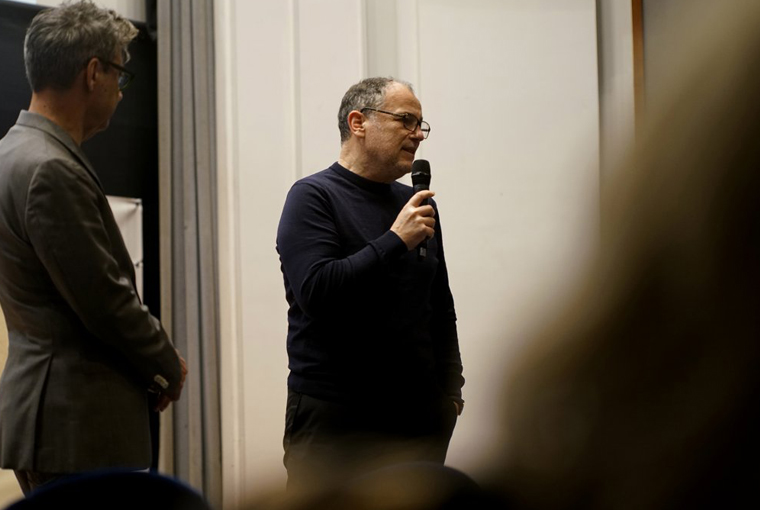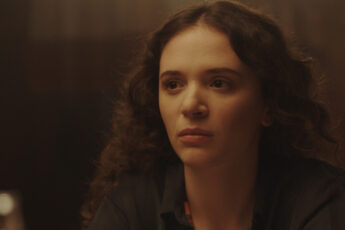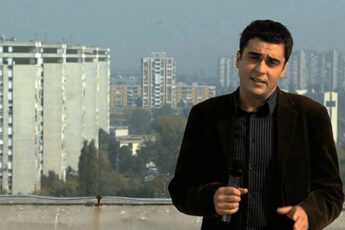
We met with Albanian visual artist Adrian Paci on the occasion of our Balkan Experimental Issue. Paci discusses the aesthetics of his work, the relevance of identity to an artist’s work, and how he approaches his own experience as an “unwanted migrant”.
How do you feel about the label of “Albanian-born and naturalized Italian artist”? How important is an artist’s identity in the process of creation and then later, in the interpretation of their artworks?
I was born in Albania during the Communist regime and I was educated as an artist in the period of socialist realism. Albania’s isolation from the rest of the world created a desire for so-called Western art. This desire grew while I was studying, when I myself was looking at books with Italian artists and seeking out references from art history. The impossibility of communicating with the world created a fantasy about the world. For me, going to Italy was not like an exploration, but a process of experiencing this imagination.
I first went to Italy with a scholarship in 1992 and stayed there for three years, before finally emigrating in 1997.
The question of identity is broader. It’s always in the process of becoming, it’s never a question of a fixed identity. That’s the beauty of it. I wouldn’t say that identity is not important, but I perceive it as something that is always in a process of transformation. So, once in Italy, life and all its difficulties created another perspective. The country that was part of my fantasies became part of my reality. These are all elements that shape your identity, which is never fixed. There was some of Italy in me before leaving Albania, and there is still some of Albania in me even though I am in Italy.
You emigrated to Italy in 1997 after a period of political and social turmoil in Albania and settled in Milan with your family. How much do your artworks draw on your own experience as an “unwanted migrant”?
Formed as an artist during socialist realism, I had wanted to explore new ways of expression, which were connected with this freedom of using artistic means of expression from the start of the 20th century, such as expressionism or abstraction. At the time, I was a painter who worked on abstract expressionist paintings. Then in Italy, I realized that this kind of art was outdated. The gap between art education in Albania and the global contemporary art scene was quite big. While the gap has narrowed, it still remains.
My very first video piece, Albanian Stories, was a response to some very simple and playful stories narrated by my daughter. I found this new tool, video, which became the necessary instrument to deal with these stories. I understood that it was not only a question of tools, but of attitude. I had been sitting in my studio, trying to figure out shapes with which to better express myself. But now I put myself in the position of the artist as a witness. The video camera captures something occurring in proximity, weaving together personal elements that unveil the intimacy of one’s own experiences while also incorporating broader contemplations and reflections. For me, the details of everyday life and personal experience can be connected with the sense of something bigger. Albanian Stories was also important because of its playfulness, despite the trauma of the conflict. These stories contained a lightness, which is something I strive to maintain in my work.
Can an artist even create artworks today without dealing with global migration and human displacement in some way? Ultimately, would you say that all art is political?
First of all, I see art as a way to give things another possibility. In that sense I think that art can deal with anything, an important or painful topic, but also with a flower, a mountain, a face, rhythm, space, light, or colors. I don’t believe that one should always deal with political topics or produce politically relevant art. Migration is never just a topic for me, but an experience. So, when you experience something, you should narrate this experience. It’s a way to express an experience. I don’t use art to inform others about the experience, but to reflect on the things which I don’t understand about my own experience. The experience itself serves to suggest images and fantasies. Thanks to this experience you can develop the imagination.
Many of your works, and in particular The Column, turn around the theme of inequality. Could you perhaps expand on how these inequalities and power dynamics play out?
When I first heard this story of a sculpture being carved while traveling on a ship in the middle of the ocean, I thought it was fantastic and weird. Like a fairy tale with an ugly twist. There is the question of capitalistic exploitation. The column is a cultural product, but the video is a cultural product, too. The Chinese workers were making the column, and I was making the video, and both of these works were created during the transition, while crossing the ocean. For me, this is an element that underlines the importance of transitory states, which are unstable. I had a strong empathy for the workers and their craft. There were ethical questions. I was filming the workers carving the marble stone, and showing this element of exploitation while somehow being part of it myself. And I am aware of this. This is why I believe an artist isn’t merely an outsider observing and passing judgment. You should always try and activate elements that would otherwise remain hidden.
I was attracted by the workers’ confidence with the marble. How they were cutting the stone, carving it, giving it a shape. I kept wondering what was happening between the stone and the workers, and I tried to give space and shape to all these possibilities of reflection. The Column was a very challenging and expensive project. Going to China to get the stone, bringing it to the ship, then going out on the ocean and carving it. I wanted the work to reveal the complexity of this process, but not to contain all the complications. I wanted to keep this lightness.
You were an art professor at the University in Shkodër, whereas upon arrival in Italy, you worked as a building restorer. I wondered about the more personal connection of The Column to your own experience and professional identity, which shifted from intellectual to manual work. Was this something you had in mind when you thought about the concept for The Column?
Not in an explicit way, but I was feeling connected with this kind of humanity which works with the body and the hands. I also appreciate silence and body language, the ability and knowledge that the hands contain. I already had this particular way of seeing before. You don’t have to go through everything personally to embody some feelings and some ways of seeing things, but maybe that element helped or influenced the work somehow. In general, I would say that people who work with their hands and articulate their position within the world through the presence and the actions of their bodies, pass on a kind of memory from generation to generation. Looking at these kinds of bodies was part of my curiosity since I was little. I remember in high school that we were drawing portraits of models who came from very marginalized parts of society, and I was admiring their faces and expressions. It all started from my own experience, and I am using my experience as a territory of possibilities.
Your other important works shown at the retrospective such as Centro di Permanenza Temporanea, Prova and Believe Me I am an Artist, invite us to reflect on the precarious and transitory state of the “migrant”, global human displacement and the role of the state and police. How do you work with migrants and refugees in your art? Could you perhaps comment on how video art allows you to create the shift from the individual experience to a shared collective experience of being a migrant and feeling displaced?
You mentioned Believe Me I am an Artist, where there is this dialog between me and the policeman. It’s a space where identity is being questioned, and at the same, it’s shaped, and you never really know what’s going on there. Actually, I am in the wrong and not the policeman. Because the artist is unable to identify himself besides saying, “I’m an artist and this is an artwork”. So what does it mean to be an artist outside of this context, where you are recognized as an artist and even celebrated as one? The identity is never fixed, it can enter a new territory where it has no meaning. That creates tensions or frictions.
For Centro di permanenza temporanea, I had this fantasy of people staying on the stairs of the airport, and my fantasy was somehow fed by images of migrants traveling on crowded boats. This image of movement somehow underlines the state of being in between. We all somehow participate in a situation, where this state of instability is present. We depart, but we do not arrive. We are in this state of leaving something or someplace and not reaching our destination.
The figure of the immigrant embodies this in a more explicit way. For instance, in Prova, this word is like the beginning of the speech which doesn’t become the speech. It remains in a state of initiation without development. It’s not only about the discourse, it’s also about the voice. The fact that the word “prova” also means “proof” and “rehearsal” and “attempt” and “try”, is something that contains different possibilities, and allows for a space for elaboration. People who live on the margins of society embody this state of in-betweenness more than others.
Migrants, refugees, and asylum seekers tend to inhabit “non-places”, such as airports, bus and train stations, police stations, border zones, refugee camps, and detention centers. It may thus not be a coincidence that the Italian name for the asylum seeker center is “Centro di permanenza temporanea”. Could you explain the significance of the title of your eponymous 2007 work and the use of the terminology “temporary permanence”? Do you feel that more and more people around the world are experiencing this type of tension between stability and instability, a form of temporary permanence?
Actually, you cannot really translate this into English. I use it as a title because it was the name of some places where they put the immigrants before deciding what to do with them, whether to send them back or to keep them. It’s a place of temporary detention, like a temporary shelter. These three words are central because it alludes to the center. So these words, permanence and temporality, created a cocktail which I found interesting. I think we live in a time of instability, not only social but environmental. There was also the pandemic situation, war, immigration, and the climate crisis, so we are in fact in a state of instability.
Your works also have this very interesting interplay of image and sound, which often creates a tension between what we see and what we hear. Could you comment on the importance and use of sound in your work, notably in Vajtojca, Interregnum and Prova?
Vajtojca is about sound because it’s about this lament, which is also an Albanian song. In Prova, it’s also about the voice which produces the sound, so you create some atmosphere around the voice which makes the sound. In Interregnum, the sound was very important, because the state funerals had music which was part of the rhetoric of images. The decision to use found footage of Communist leaders’ funerals gave me an idea about the kind of sound to use for the piece. I was working with the sound designer, and the desire was to create this alienating atmosphere. The alienation was also there in the images. Sound is important for me, but I always try to avoid turning formal elements into the protagonists of my work. Image and sound and all the elements should collectively build the work as a whole and not work as separate formal elements.
Interregnum (2017) juxtaposes state-sanctioned archival footage from the 1920s to 1980s, from Albania, Yugoslavia, China, North Korea, and the Soviet Union, which documents acts of national mourning for the deaths of Communist leaders. Aside from engaging with the politics of memory, the compression of original sound from the archival footage in Interregnum into a sonic hum, creates a continuous thread running across the disparate images, and suggests the idea of a traumatized collective body and a kind of transmemorial project. Could you expand on your views of our contemporary mechanizations of the politics of memory, in particular, the memory of socialism?
In a regime, life becomes like a theater, a stage. I was experiencing this very strongly living in Albania. You were not allowed to be unhappy in this narrative, it was all about joy, strength, feeling secure and having a bright future in front of you. The theater of joy and strength only turned into a stage of pain when the dictator passed away, granting you not just the permission but the request to express your grief. Everything was orchestrated to underline this collective pain. To show this, I decided to exclude the dead body of the dictator, the real fact of the funeral, and only leave the political, collective, and fictional body of the people mourning. I also wanted to show this collective body from Asia to Europe through different times, and create this movement in space and time. To give a kind of rhythm, and create a big portrait of this kind of political body.
The title seems to refer to Antonio Gramsci’s concept of “interregnum”, which he writes about in his prison notebooks (1929-1935), where he discusses the so-called “morbid symptoms” emerging from the political polarization during that era. What parallels do you see between this historical period and our current one?
I’ve had Interregnum in my mind for 12 years. I thought about it in 2005 for the first time, and then kept it in my mind for a while, finally creating it in 2017. It was the right moment then. It was the time when populist movements started gaining ground. Ultimately, there comes a moment when an idea or concept from the past, along with the imaginative constructs associated with it, undergoes a reactualization, somehow becoming tangible and real once again. The state of interregnum is when the old has already died, but the new hasn’t been born yet. Gramsci talked about these morbid symptoms and I think we can feel them today, too.
Thank you for the interview.




Leave a Comment